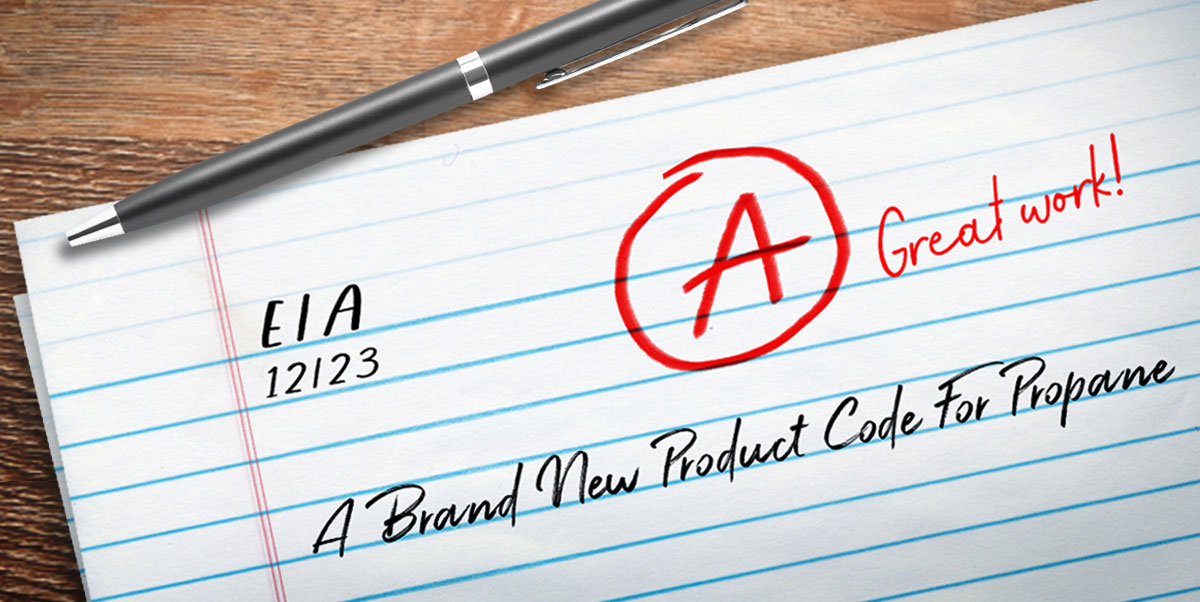The EIA Receives an "A" for New Propane Product

The Energy Information Administration (EIA) has a brand new product code for propane that will allow industry folks to know, by region, how much propane is readily available for sale. This should be good stuff!
Five years ago we wrote a blog titled Y-Grade Gets an Incomplete.
The issue, at the time, was that natural gas liquids production was so robust that it began to exceed fractionation capacity. This situation forced many producers to store some of the raw, unseparated mix (called y-grade) to be separated later. The y-grade designation supposedly came from a Texas pipeline company that assigned different letters to different petroleum products.
Part of the Mix was Part of the Problem.
NGL inventory holders are required to report how much propane they have in inventory to the EIA. Much of the propane they report has already been fractionated (separated out) from the natural gas liquids mix and is available to be withdrawn from inventory as “purity” propane.
But some of the propane has not been separated out from the y-grade, or it’s a part of unfractionated mixed NGLs.
Basically, it’s still just a percentage of the primordial natural gas liquids stew. So, the weekly inventory numbers we’ve all been talking about, and referencing for years, has included propane that wasn’t even “ready for sale” propane yet. I’m not sure many people know this.
Candy Production Exceeded Processing Capacity.
The previous blog included the famous “Candy Factory” scene from I Love Lucy which is impossible to watch without laughing. The analogy was that chocolate candy production exceeded processing capacity.
What did Ethel and Lucy do when that happened? Well, they stuffed their blouses and filled their hats with the chocolates they couldn’t process. NGL producers can’t do that (without people talking about them), so they put the raw “mix” they haven’t separated yet into storage.
To wrap up the I Love Lucy analogy, in terms of the EIA, Lucy would also be required to fill out a report with how many chocolates she and Ethel processed including all of the candy that was not yet wrapped or ready for sale but still piled up under their hats or tucked into their blouses.
Propane, Fractionated and Ready for Sale.
But good things are worth waiting for and we need to cheer the brand new product line that the EIA will include in their Weekly Petroleum Status Report titled “Propane, Fractionated and Ready for Sale.”
The EIA received approval for this new product code from the Office of Management and Budget (OMB) and has begun collecting the information and checking the data to make sure that it’s both valid and meets the EIA’s statistical guidelines. After the monthly data hits their reports, the EIA’s internal mechanisms will allow them to start generating weekly publications for regional stocks by PAD Districts of “Propane, Fractionated and Ready for Sale.”
Warren Wilczewski, Senior Technical Adviser for the EIA, told us recently that the “new product line will be a subset of the total.”
So there will be a grand total for propane inventories by PAD Districts and another subset that excludes the propane component of unfractionated mixed products and propylene.
This should be really helpful information for the propane industry. We’ll finally be able to see how much of the propane in the weekly inventory numbers is readily available propane that can be withdrawn from inventory to meet heating demand. Or heat water, cook meals, dry clothes, fuel autogas vehicles (cars, vans, busses) or generate electricity, among many other versatile uses.
Side Note: The new data will include small quantities of HD-10 grade propane. This is mostly sold in California for industrial applications due to its higher propylene content versus HD-5 propane (minimum 90% propane, maximum 5% propylene) which is the consumer-grade propane most commonly sold.
Weekly Inventory Numbers
U.S. propane inventories showed a larger than expected draw of 2.19 mmbbls. for the week ending December 15, 2023. This brings national inventory levels to 93.73 mmbbls., about 7% above last year and 19% above the 5-year average.
PADD 1 (East Coast) inventories showed a negligible build of .16 mmbbls. They stand at 8.86 mmbbls. about 19% above last year.
PADD 2 (Midwest/Conway) inventories had a minimal draw of .16 mmbbls. They stand at 28.53 mmbbls., nearly 11% higher than last year.
PADD 3 (Gulf Coast/Belvieu) inventories recorded a healthy draw of 1.81 mmbbls. They stand at 50.11 mmbbls., largely unchanged versus last year.
The Skinny
U.S. propane inventory information is only valuable to decision-makers within our industry if the information is accurate and transparent. Unfortunately, for many years now, the total amount of “purity” propane reported to be in inventory has actually still been part of the primordial natural gas liquids stew.
Kudos to the EIA for now making the weekly propane inventory numbers much more meaningful.
And while we’re handing out props and kudos, many thanks to our wonderful customers who deserve all the credit for Ray Energy’s remarkable growth. We wouldn’t be where we are today without you! We wish you and your family best wishes during the holiday season, full of much happiness and lots of propane.

Get Stephen's insights on propane delivered to your inbox every month. Sign up for our monthly newsletter here.
For more frequent updates and industry news, join us on LinkedIn.
NOTE: The views and opinions expressed herein are solely those of the author, unless attributed to a third-party source, and do not necessarily reflect the views of Ray Energy Corp, its affiliates, or its employees. The information set forth herein has been obtained or derived from sources believed by the author to be reliable. However, the author does not make any representation or warranty, express or implied, as to the information’s accuracy or completeness, nor does the author recommend that the attached information serve as the basis of any buying decision and it has been provided to you solely for informational purposes. © 2011-2023 Ray Energy Corp. All rights reserved. Any reproduction, representation, adaptation, translation, and/or transformation, in whole or in part by whatsoever process, of this site or of one or several of its components, is forbidden without the express written authorization from Ray Energy Corp.

